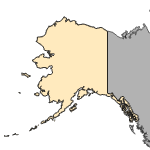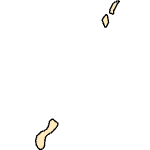Devario malabaricus
(Malabar danio)
Fishes
Exotic |
|
Common name: Malabar danio
Synonyms and Other Names: giant danio, Danio malabaricus
Taxonomy: available through
www.itis.gov
Identification: Recent systematic review and distinguishing characteristics were provided by Jayaram (1991) and Kullander (2001). A key, distinguishing characteristics, and figure were given in Talwar and Jhingran (1991). Color photographs of live fish appeared in Axelrod et al. (1985).
Size: 12 cm TL.
Native Range: Tropical Asia, southwestern India and Sri Lanka (Jayaram 1991).



|

Alaska |

Hawaii |

Puerto Rico &
Virgin Islands |

Guam Saipan |
Hydrologic Unit Codes (HUCs) Explained
Interactive maps: Point Distribution Maps
Nonindigenous Occurrences:
Table 1. States with nonindigenous occurrences, the earliest and latest observations in each state, and the tally and names of HUCs with observations†. Names and dates are hyperlinked to their relevant specimen records. The list of references for all nonindigenous occurrences of Devario malabaricus are found here.
Table last updated 12/20/2025
† Populations may not be currently present.
Means of Introduction: The Hillsborough County, Florida, introductions were probably due to releases or escapes from local fish farms. The Nevada introduction likely represents the result of an aquarium release.
Status: Failed in Florida and Nevada.
Impact of Introduction: The impacts of this species are currently unknown, as no studies have been done to determine how it has affected ecosystems in the invaded range. The absence of data does not equate to lack of effects. It does, however, mean that research is required to evaluate effects before conclusions can be made.
References: (click for full references)
Axelrod, H.R., W.E. Burgess, N. Pronek, and J.G. Walls. 1985. Dr. Axelrod's atlas of freshwater aquarium fishes. Tropical Fish Hobbyists Publications, Inc, Neptune City, NJ. 780 pp.
Courtenay, W.R., Jr. and D.A. Hensley. 1979. Range expansion in southern Florida of the introduced spotted tilapia, with comments on its environmental impress. Environmental Conservation 6(1):149-151.
Courtenay, W.R., Jr., D.A. Hensley, J.N. Taylor, and J.A. McCann. 1984. Distribution of exotic fishes in the continental United States. IN W.R. Courtenay, Jr., and J.R. Stauffer, Jr., eds. Distribution, Biology and Management of Exotic Fishes. John Hopkins University Press Baltimore, MD. 41-77.
Courtenay, W.R., Jr., D.P. Jennings, and J.D. Williams. 1991. Appendix 2: Exotic Fishes IN Common names and scientific names of fishes from the United States and Canada. American Fisheries Society, Special Publication. 5th ed. 20.
Jayaram, K.C. 1991. Systematic status of Danio malabaricus (Pisces: Cyprinidae). Ichthyological Exploration of Freshwaters 2:109-112.
Kullander, F.F. 2001. Phylogeny and species diversity of the South and Southeast Asian cyprinid genus Danio Hamilton (Teleostei, Cyprinidae). Ph.D. Thesis-Stockholm University, Department of Zoology. p. 1-26. Sweden, Stockholm University, Department of Zoology.
Shafland, P.L. 1976. The continuing problem of non-native fishes in Florida. Fisheries 1(6):25.
Talwar, P.K. and A.G. Jhingran (editors). 1991. Inland fishes of India and adjacent countries. Two volumes. AA Balkema, Rotterdam, The Netherlands. 1158 p.
FishBase Summary
Author:
Leo Nico, and Bill Loftus
Revision Date: 7/24/2019
Peer Review Date: 7/30/2012
Citation Information:
Leo Nico, and Bill Loftus, 2025, Devario malabaricus (Jerdon, 1849): U.S. Geological Survey, Nonindigenous Aquatic Species Database, Gainesville, FL, https://nas.er.usgs.gov/Queries/FactSheet.aspx?SpeciesID=527, Revision Date: 7/24/2019, Peer Review Date: 7/30/2012, Access Date: 12/20/2025
This information is preliminary or provisional and is subject to revision. It is being provided to meet the need for timely best science. The information has not received final approval by the U.S. Geological Survey (USGS) and is provided on the condition that neither the USGS nor the U.S. Government shall be held liable for any damages resulting from the authorized or unauthorized use of the information.